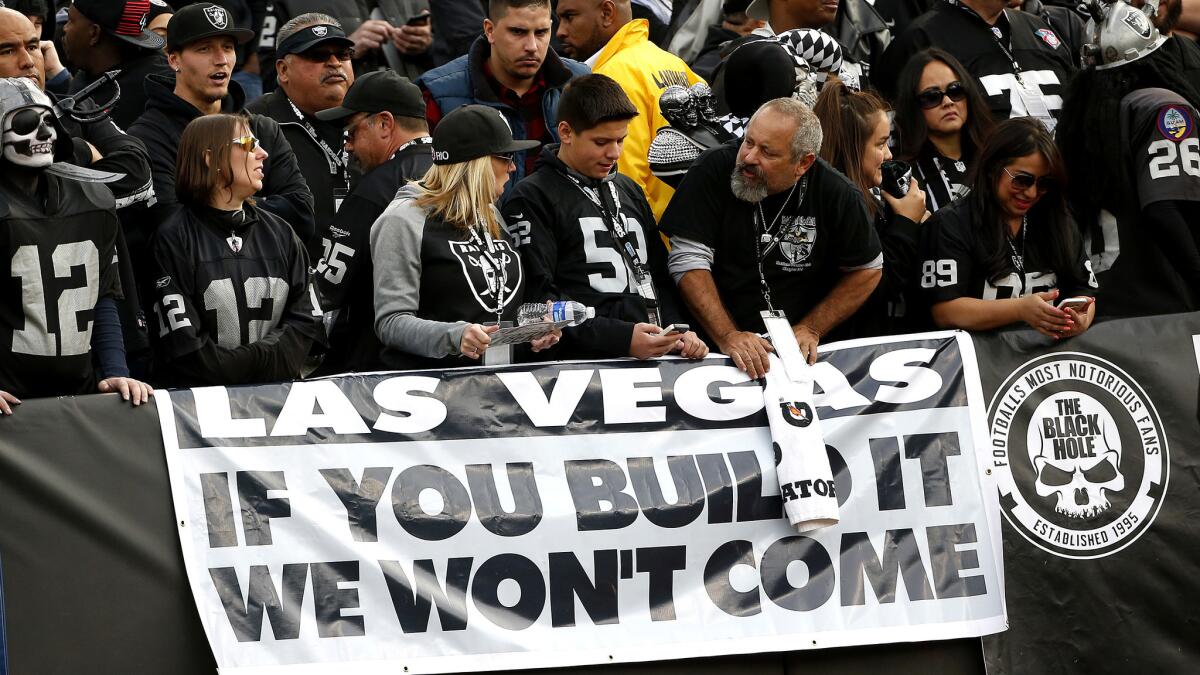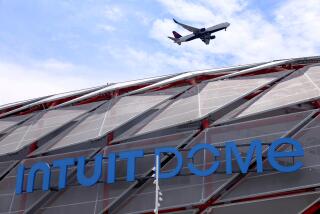Lawmakers have put a lot of energy into getting new stadiums built — without much success

Reporting from Sacramento — With the Raiders deciding to leave Oakland for a $1.9-billion football stadium in Las Vegas, the carousel of moves and threats to move by California’s professional sports teams appears to be slowing down. So too does all the action in the state Legislature designed to help build new stadiums.
Since 2009, state lawmakers have tried to make it easier to build new football stadiums in the San Gabriel Valley, San Diego and downtown Los Angeles, and basketball arenas in Sacramento and San Francisco. Although many of the bills were passed during frantic, dead-of-the-night gambits to meet state budget or end-of-session deadlines, with the exception of legislation for a new Sacramento Kings arena, lawmakers don’t have much to show for their efforts.
“I think when you have an opportunity to create significant economic development in our state that it is worth trying,” said Sacramento Mayor Darrell Steinberg, who led the state Senate from 2008 to 2014 and was at the center of many of the bills to speed the development process for stadiums. “Sometimes you succeed, sometimes you don’t. And you know for sure when you don’t try, you have no chance.”
None of the football stadiums lawmakers passed special legislation to benefit since 2009 were built. The Rams-Chargers stadium now under construction in Inglewood bypassed help from lawmakers, following a strategy that involved collecting signatures from residents supporting the project. This method allowed Inglewood’s City Council to approve the stadium just six weeks after the team unveiled plans — far quicker than most of the bills legislators passed would have.
A measure that aimed to help the under-construction Warriors basketball arena didn’t meet the key deadline prescribed in the law to wrap up an environmental lawsuit against the project within nine months. Team officials have credited the state’s efforts, however, with speeding up construction.
The lone bill that made an unquestionable difference in getting an arena built was Steinberg’s Senate Bill 743 in 2013, which gave the Sacramento Kings shortcuts in defending environmental lawsuits against their downtown arena project, such as limiting a judge’s ability to halt construction unless there were serious health and safety risks.
At the time, investors from Washington had come close to purchasing the team and moving it to Seattle. The state’s intervention helped a new Sacramento-based ownership group meet NBA deadlines for building a new arena. The Kings opened the Golden 1 Center in downtown Sacramento last fall.
“You look at the end result and it was phenomenal,” Steinberg said of the new arena. “Without that bill, it would not have happened. The delays would have killed the project.”
Even though the bills didn’t lead to much stadium construction, they faced significant criticism and lobbying from Capitol heavyweights before they were passed. The majority of the measures were designed to help the stadiums deal with provisions in the California Environmental Quality Act, the state’s premier environmental law governing development, which requires developers to disclose and minimize a project’s environmental effects.
Environmental and labor groups are staunch CEQA supporters, and businesses also have threatened CEQA lawsuits against competitors, so any changes to the law are closely watched by powerful interests. At the same time, many critics argued during debates over the bills that measures to speed up CEQA lawsuits shouldn’t exclusively benefit stadiums, and should apply to other projects.
Both Senate Bill 743 and a bill two years earlier to provide a speedy timeline for potential lawsuits against a proposed football stadium in downtown Los Angeles took until the final day of the legislative session to pass.
Bills to speed stadium development are “hard to do because you’re balancing multiple sets of interests at the same time: holding true to environmental standards and also trying to expedite,” said John A. Pérez, a former Democratic legislator from Los Angeles who helped broker stadium deals as Assembly speaker from 2010 to 2014.
During the depths of the state’s economic recession in 2010, lawmakers were more than three months late in delivering a state budget. Back then, a two-thirds supermajority of lawmakers were needed to pass the budget, which required a handful of GOP legislators to join the ruling Democratic majority.
In exchange for his budget vote, then-Republican Assemblyman Nathan Fletcher of San Diego wanted legislation to lift a state cap on downtown San Diego’s urban renewal program, which was a significant impediment at the time to financing a planned Chargers stadium.
The measure, which was unveiled on the Assembly floor a little before midnight, attracted vociferous opposition from Fletcher’s colleagues. As budget talks dragged on, then-Republican Assemblyman Chris Norby took a nap, thinking he had rallied enough colleagues to defeat the bill. When Norby woke up, he found the legislation had passed at 3 a.m. and was on its way to the governor’s desk alongside the budget.
Fletcher’s bill, however, had a short shelf life. The following year, the Legislature killed the urban renewal program statewide. The Chargers, despite more legislative help in 2015 for a different San Diego stadium proposal, decided in January to move to Los Angeles.
Aside from the 2010 bill, none of the other stadium legislation involved spending taxpayer money, though the Kings arena includes a substantial sum of Sacramento city dollars.
Pérez and Steinberg contrasted state lawmakers’ efforts to lessen regulations to build stadiums with the Nevada Legislature’s pledge of $750 million, a record public subsidy, to build the new Raiders’ stadium. Steinberg called Nevada lawmakers’ decision “highway robbery.”
Even if other pro sports teams come calling in the future for help from California lawmakers, Pérez and Steinberg said they believed there was a limit to what the state would do. An overwhelming percentage of economists believe local and state governments should eliminate public subsidies to professional sports franchises because they don’t pay off for taxpayers, according to survey results compiled by Harvard economist N. Gregory Mankiw.
“Throwing public money at attracting a team is a horrible use of public resources,” Pérez said.
Timeline: How California lawmakers tried to get sports stadiums built »
Twitter: @dillonliam
ALSO
What Californians need to know about the state’s $52-billion transportation plan
Democrats moving senior staffers to Orange County in an effort to flip Republican House seats
Updates on California politics
More to Read
Get the L.A. Times Politics newsletter
Deeply reported insights into legislation, politics and policy from Sacramento, Washington and beyond. In your inbox three times per week.
You may occasionally receive promotional content from the Los Angeles Times.











